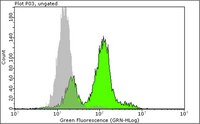04-789 Sigma-AldrichAnti-phospho-Histone H3 (Thr11) Antibody, clone MC83, rabbit monoclonal
Anti-phospho-Histone H3 (Thr11) Antibody, clone MC83 is a rabbit monoclonal antibody for detection of phospho-Histone H3 (Thr11) also known as H3T11P, Histone H3 (phospho T11) & has been validated in WB, PIA, Mplex.
More>> Anti-phospho-Histone H3 (Thr11) Antibody, clone MC83 is a rabbit monoclonal antibody for detection of phospho-Histone H3 (Thr11) also known as H3T11P, Histone H3 (phospho T11) & has been validated in WB, PIA, Mplex. Less<<Recommended Products
Overview
| Replacement Information |
|---|
Key Specifications Table
| Species Reactivity | Key Applications | Host | Format | Antibody Type |
|---|---|---|---|---|
| H | WB, PIA, Mplex | Rb | Culture Supernatant | Monoclonal Antibody |
| References |
|---|
| Product Information | |
|---|---|
| Format | Culture Supernatant |
| HS Code | 3002 15 90 |
| Control |
|
| Presentation | Cultured supernantant in 0.05% sodium azide |
| Quality Level | MQ100 |
| Physicochemical Information |
|---|
| Dimensions |
|---|
| Materials Information |
|---|
| Toxicological Information |
|---|
| Safety Information according to GHS |
|---|
| Safety Information |
|---|
| Storage and Shipping Information | |
|---|---|
| Storage Conditions | Stable for 1 year at -20°C from date of receipt. For maximum recovery of product, centrifuge the vial prior to removing the cap. |
| Packaging Information | |
|---|---|
| Material Size | 200 µL |
| Transport Information |
|---|
| Supplemental Information |
|---|
| Specifications |
|---|
| Global Trade Item Number | |
|---|---|
| Catalog Number | GTIN |
| 04-789 | 04053252409332 |
Documentation
Anti-phospho-Histone H3 (Thr11) Antibody, clone MC83, rabbit monoclonal SDS
| Title |
|---|












